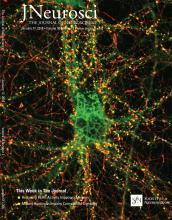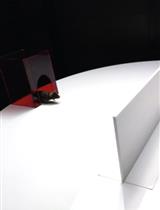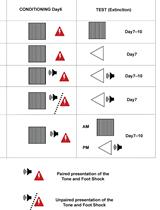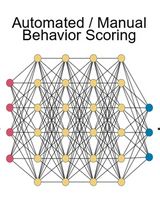- EN - English
- CN - 中文
Trace Fear Conditioning: Procedure for Assessing Complex Hippocampal Function in Mice
痕迹条件性恐惧:小鼠中检测海马复杂性功能的步骤
发布: 2018年08月20日第8卷第16期 DOI: 10.21769/BioProtoc.2475 浏览次数: 9929
评审: Anonymous reviewer(s)
Abstract
The trace fear conditioning protocol is designed to measure hippocampal function in mice. The protocol includes a neutral conditioned stimulus (tone) and an aversive unconditioned stimulus (shock), separated in time by a trace interval. The trace interval between the tone and the shock critically involves the hippocampus and could be used to evaluate hippocampal-dependent learning and memory. In this protocol, we presented mice with five pairings of tone and shock separated by a 20 sec trace interval. Freezing was measured 24 h after conditioning to evaluate contextual memory by placing mice in the conditioned chamber. In addition, 48 h after conditioning, freezing was measured in a dark chamber, which served as a different context. This method enables precise detection of hippocampal-dependent learning and memory following pharmacological and genetic manipulations that impair or enhance hippocampal function.
Keywords: Trace fear conditioning (TFC) (痕迹条件性恐惧)Background
The trace fear conditioning (TFC) paradigm differs from standard fear conditioning paradigms (Heise et al., 2017; Segev et al., 2013 and 2015) by the simple insertion of a trace interval between a conditioned stimulus (CS, e.g., tone) and an unconditioned stimulus (US, e.g., electric foot shock), and repeated application of their combination at fixed intervals. The TFC paradigm involves the formation of temporally non-contiguous associations in both natural and pathological conditions, and is considered a complex, hippocampal-dependent paradigm, in contrast to simple cortical-dependent learning paradigms such as taste learning (Stern et al., 2013; Ounallah-Saad et al., 2014; Rappaport et al., 2015; Levitan et al., 2016; Sharma et al., 2018). A remarkable aspect of trace fear conditioning is that it provides a reliable model of attention-dependent associative learning that reflects the complex processing of the hippocampus and alters the circuitry recruited for learning. Several studies have shown that hippocampal lesions before and after training impair the ability of the animal to associate the CS and US stimuli when they are separated by the trace interval (Bangasser et al., 2006; Esclassan et al., 2009). However, animals with hippocampal lesions could associate the CS and US in a delay situation, where no trace interval separates them, but the CS and US co-terminate (McEchron et al., 1998; McEchron et al., 2000; Quinn et al., 2002). Although other brain regions such as the medial prefrontal cortex (Peters et al., 2009; Beeman et al., 2013), the entorhinal and perirhinal cortices (Esclassan et al., 2009; Kent and Brown, 2012), and the amygdala (Pape and Pare, 2010; Gilmartin et al., 2012) are involved in relaying stimulus inputs and response outputs, the hippocampus is selectively involved in trace conditioning rather than general fear learning or expression. Moreover, the acquisition of trace fear conditioning increases intrinsic excitability and facilitates LTP in pyramidal neurons of the hippocampus (Song et al., 2012), which makes trace fear conditioning an ideal paradigm to test hippocampal function in young and aged mice (Sharma et al., 2018).
Materials and Reagents
- Animals
Male C57BL/6 mice (Envigo, Jerusalem) weighing 20-25 g and approximately 12 weeks old were used in this study. This protocol can also be used to study the function of the hippocampus in other strains and different age groups of mice (Shoji et al., 2016; Sharma et al., 2018). The mice were housed individually, on a 12/12 h light/dark cycle, and provided with water and standard rodent chow ad libitum. Animals were handled according to approved protocols and animal welfare regulations of the University of Haifa Institutional Ethics Committee. - 70% ethanol (Fisher Scientific, catalog number: BP82011 )
Equipment
- TFC chambers (Coulbourn Instruments, model: H10-11M-TC )
Place TFC chambers measuring 25 x 25 x 25 cm internally inside a larger, insulated plastic cabinet that excludes external light and noise (Panlab, Harvard Apparatus, model: LE116 76-0280 ). - Visual (CCD) and infrared camera (Sensor Technologies America, model: STC-CMB4MPOE ) along with an infrared illuminator (Bosch, model: EX12LED-3BD-8W ).
Software
- FreezeFrame 3.0 and FreezeView software (Coulbourn Instruments)
Note: Both software components can be downloaded from the Actimetrics website. - FreezeView manual
Note: The manual can be downloaded from the Coulbourn webpage.
Procedure
文章信息
版权信息
© 2018 The Authors; exclusive licensee Bio-protocol LLC.
如何引用
Readers should cite both the Bio-protocol article and the original research article where this protocol was used:
- Sharma, V., Cohen, N., Sood, R., Ounallah-Saad, H., Gal Ben-Ari, S. and Rosenblum, K. (2018). Trace Fear Conditioning: Procedure for Assessing Complex Hippocampal Function in Mice. Bio-protocol 8(16): e2475. DOI: 10.21769/BioProtoc.2475.
- Sharma, V., Ounallah-Saad, H., Chakraborty, D., Hleihil, M., Sood, R., Barrera, I., Edry, E., Kolatt Chandran, S., Ben Tabou de Leon, S., Kaphzan, H. and Rosenblum, K. (2018). Local inhibition of PERK enhances memory and reverses age-related deterioration of cognitive and neuronal properties. J Neurosci 38(3): 648-658.
分类
神经科学 > 行为神经科学 > 学习和记忆
您对这篇实验方法有问题吗?
在此处发布您的问题,我们将邀请本文作者来回答。同时,我们会将您的问题发布到Bio-protocol Exchange,以便寻求社区成员的帮助。
提问指南
+ 问题描述
写下详细的问题描述,包括所有有助于他人回答您问题的信息(例如实验过程、条件和相关图像等)。
Share
Bluesky
X
Copy link












